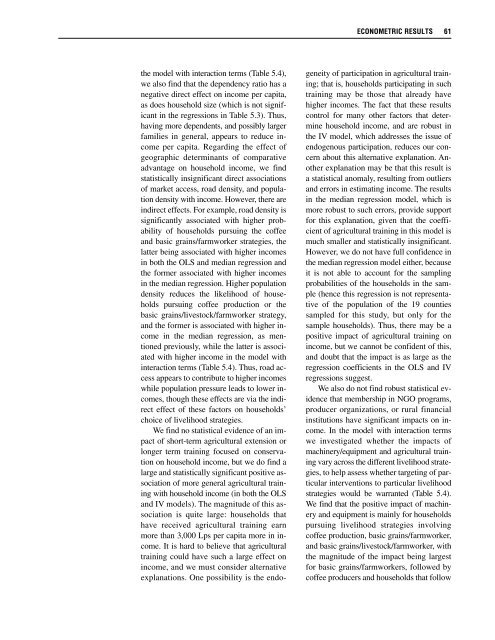Rural Development Policies and Sustainable Land Use in the ...
Rural Development Policies and Sustainable Land Use in the ...
Rural Development Policies and Sustainable Land Use in the ...
You also want an ePaper? Increase the reach of your titles
YUMPU automatically turns print PDFs into web optimized ePapers that Google loves.
ECONOMETRIC RESULTS 61<br />
<strong>the</strong> model with <strong>in</strong>teraction terms (Table 5.4),<br />
we also f<strong>in</strong>d that <strong>the</strong> dependency ratio has a<br />
negative direct effect on <strong>in</strong>come per capita,<br />
as does household size (which is not significant<br />
<strong>in</strong> <strong>the</strong> regressions <strong>in</strong> Table 5.3). Thus,<br />
hav<strong>in</strong>g more dependents, <strong>and</strong> possibly larger<br />
families <strong>in</strong> general, appears to reduce <strong>in</strong>come<br />
per capita. Regard<strong>in</strong>g <strong>the</strong> effect of<br />
geographic determ<strong>in</strong>ants of comparative<br />
advantage on household <strong>in</strong>come, we f<strong>in</strong>d<br />
statistically <strong>in</strong>significant direct associations<br />
of market access, road density, <strong>and</strong> population<br />
density with <strong>in</strong>come. However, <strong>the</strong>re are<br />
<strong>in</strong>direct effects. For example, road density is<br />
significantly associated with higher probability<br />
of households pursu<strong>in</strong>g <strong>the</strong> coffee<br />
<strong>and</strong> basic gra<strong>in</strong>s/farmworker strategies, <strong>the</strong><br />
latter be<strong>in</strong>g associated with higher <strong>in</strong>comes<br />
<strong>in</strong> both <strong>the</strong> OLS <strong>and</strong> median regression <strong>and</strong><br />
<strong>the</strong> former associated with higher <strong>in</strong>comes<br />
<strong>in</strong> <strong>the</strong> median regression. Higher population<br />
density reduces <strong>the</strong> likelihood of households<br />
pursu<strong>in</strong>g coffee production or <strong>the</strong><br />
basic gra<strong>in</strong>s/livestock/farmworker strategy,<br />
<strong>and</strong> <strong>the</strong> former is associated with higher <strong>in</strong>come<br />
<strong>in</strong> <strong>the</strong> median regression, as mentioned<br />
previously, while <strong>the</strong> latter is associated<br />
with higher <strong>in</strong>come <strong>in</strong> <strong>the</strong> model with<br />
<strong>in</strong>teraction terms (Table 5.4). Thus, road access<br />
appears to contribute to higher <strong>in</strong>comes<br />
while population pressure leads to lower <strong>in</strong>comes,<br />
though <strong>the</strong>se effects are via <strong>the</strong> <strong>in</strong>direct<br />
effect of <strong>the</strong>se factors on households’<br />
choice of livelihood strategies.<br />
We f<strong>in</strong>d no statistical evidence of an impact<br />
of short-term agricultural extension or<br />
longer term tra<strong>in</strong><strong>in</strong>g focused on conservation<br />
on household <strong>in</strong>come, but we do f<strong>in</strong>d a<br />
large <strong>and</strong> statistically significant positive association<br />
of more general agricultural tra<strong>in</strong><strong>in</strong>g<br />
with household <strong>in</strong>come (<strong>in</strong> both <strong>the</strong> OLS<br />
<strong>and</strong> IV models). The magnitude of this association<br />
is quite large: households that<br />
have received agricultural tra<strong>in</strong><strong>in</strong>g earn<br />
more than 3,000 Lps per capita more <strong>in</strong> <strong>in</strong>come.<br />
It is hard to believe that agricultural<br />
tra<strong>in</strong><strong>in</strong>g could have such a large effect on<br />
<strong>in</strong>come, <strong>and</strong> we must consider alternative<br />
explanations. One possibility is <strong>the</strong> endogeneity<br />
of participation <strong>in</strong> agricultural tra<strong>in</strong><strong>in</strong>g;<br />
that is, households participat<strong>in</strong>g <strong>in</strong> such<br />
tra<strong>in</strong><strong>in</strong>g may be those that already have<br />
higher <strong>in</strong>comes. The fact that <strong>the</strong>se results<br />
control for many o<strong>the</strong>r factors that determ<strong>in</strong>e<br />
household <strong>in</strong>come, <strong>and</strong> are robust <strong>in</strong><br />
<strong>the</strong> IV model, which addresses <strong>the</strong> issue of<br />
endogenous participation, reduces our concern<br />
about this alternative explanation. Ano<strong>the</strong>r<br />
explanation may be that this result is<br />
a statistical anomaly, result<strong>in</strong>g from outliers<br />
<strong>and</strong> errors <strong>in</strong> estimat<strong>in</strong>g <strong>in</strong>come. The results<br />
<strong>in</strong> <strong>the</strong> median regression model, which is<br />
more robust to such errors, provide support<br />
for this explanation, given that <strong>the</strong> coefficient<br />
of agricultural tra<strong>in</strong><strong>in</strong>g <strong>in</strong> this model is<br />
much smaller <strong>and</strong> statistically <strong>in</strong>significant.<br />
However, we do not have full confidence <strong>in</strong><br />
<strong>the</strong> median regression model ei<strong>the</strong>r, because<br />
it is not able to account for <strong>the</strong> sampl<strong>in</strong>g<br />
probabilities of <strong>the</strong> households <strong>in</strong> <strong>the</strong> sample<br />
(hence this regression is not representative<br />
of <strong>the</strong> population of <strong>the</strong> 19 counties<br />
sampled for this study, but only for <strong>the</strong><br />
sample households). Thus, <strong>the</strong>re may be a<br />
positive impact of agricultural tra<strong>in</strong><strong>in</strong>g on<br />
<strong>in</strong>come, but we cannot be confident of this,<br />
<strong>and</strong> doubt that <strong>the</strong> impact is as large as <strong>the</strong><br />
regression coefficients <strong>in</strong> <strong>the</strong> OLS <strong>and</strong> IV<br />
regressions suggest.<br />
We also do not f<strong>in</strong>d robust statistical evidence<br />
that membership <strong>in</strong> NGO programs,<br />
producer organizations, or rural f<strong>in</strong>ancial<br />
<strong>in</strong>stitutions have significant impacts on <strong>in</strong>come.<br />
In <strong>the</strong> model with <strong>in</strong>teraction terms<br />
we <strong>in</strong>vestigated whe<strong>the</strong>r <strong>the</strong> impacts of<br />
mach<strong>in</strong>ery/equipment <strong>and</strong> agricultural tra<strong>in</strong><strong>in</strong>g<br />
vary across <strong>the</strong> different livelihood strategies,<br />
to help assess whe<strong>the</strong>r target<strong>in</strong>g of particular<br />
<strong>in</strong>terventions to particular livelihood<br />
strategies would be warranted (Table 5.4).<br />
We f<strong>in</strong>d that <strong>the</strong> positive impact of mach<strong>in</strong>ery<br />
<strong>and</strong> equipment is ma<strong>in</strong>ly for households<br />
pursu<strong>in</strong>g livelihood strategies <strong>in</strong>volv<strong>in</strong>g<br />
coffee production, basic gra<strong>in</strong>s/farmworker,<br />
<strong>and</strong> basic gra<strong>in</strong>s/livestock/farmworker, with<br />
<strong>the</strong> magnitude of <strong>the</strong> impact be<strong>in</strong>g largest<br />
for basic gra<strong>in</strong>s/farmworkers, followed by<br />
coffee producers <strong>and</strong> households that follow
















